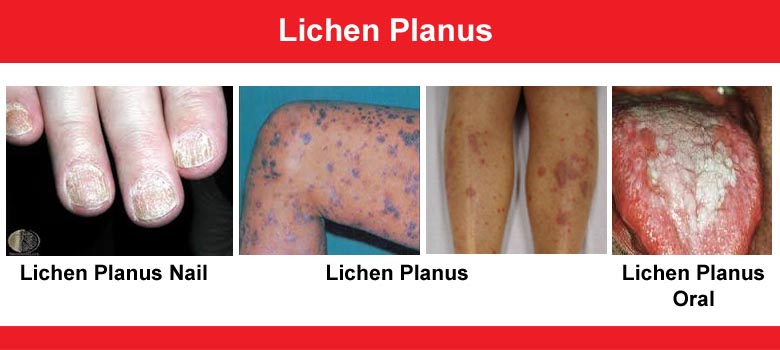108 Glen Osmond Road, Parkside

If you have a rash with red, purple, or bluish lesions that itches and spreads, you may have lichen planus. This disease is triggered by the immune system in response to stress, allergens, or viral infection. It may affect the skin, scalp, nails, mouth, and genitalia.

Lichen planus is a chronic, recurrent skin disease of unknown cause. It generally affects adults and can involve any portion of the skin and mucous membrane.
CHARACTERISTICS OF RASH:

SIGNS & SYMPTOMS:
TYPES- Main 4 types:
AYURVEDIC VIEW OF LICHEN PLANUS:
Charma Kushtha is a clinical condition that resembles LP. Charma Kushtha is dominant of Vata and Kapha dosha. Itching, hyperkeratosis, sliminess, and thickness are all features of KAPHA dominancy. Acanthosis (Karshnya) is a feature of aggravated Vata. The etiology of Kushtha is Visha (anti-immune), usually resulting from external environmental factors or due to the consumption of incompatible food. Stress causes vitiation of Rasa Dhatu which causes Kapha Dushti.
AYURVEDIC TREATMENT OF LICHEN PLANUS:
In Ayurveda, we recommend a comprehensive treatment strategy that involves strengthening digestion and detoxifying and eliminating toxins. Ayurvedic treatment aims to rid the body of accumulated toxins by Panchkarma. We recommend herbal formulations and local application.
Single herb for LP treatment:
Lichen planus is a chronic inflammatory condition that affects the skin, mucous membranes, hair, and nails. Ayurvedic and naturopathic approaches aim to balance the body’s internal systems, reduce inflammation, and support the immune system using natural herbs and remedies. In Ayurveda, lichen planus is often associated with Rakta Dhatu Dushti (vitiation of blood tissue) and imbalances in Pitta and Vata doshas. Herbs like Turmeric (Curcuma longa) are widely used due to their powerful anti-inflammatory and immunomodulatory effects; the active compound curcumin helps suppress immune overactivity and soothes inflamed tissues. Neem (Azadirachta indica) is another key herb, renowned for its blood-purifying, antifungal, and anti-inflammatory properties, helping to detoxify the body and prevent flare-ups. Manjistha (Rubia cordifolia) supports lymphatic drainage and purifies blood, aiding in the reduction of skin lesions and pigmentation. Guduchi (Tinospora cordifolia) acts as an adaptogen and immunomodulator, calming autoimmune responses and enhancing tissue healing. Naturopathy often complements these herbs with dietary changes, emphasizing an anti-inflammatory, plant-based diet rich in antioxidants to reduce oxidative stress. Aloe vera is also commonly used both topically and internally to soothe mucosal linings and promote skin regeneration. Together, these herbs aim not only to treat the symptoms but also to address the root cause of lichen planus by enhancing immunity, detoxification, and systemic balance in the body.
Internal administration:
Local application:
If you are suffering from Lichen Planus, do not delay in contacting the specialist Ayurvedic doctors' team at Life Line Ayurvedic Herbal Clinic to get rid of your health problems as soon as possible.
Disclaimer : Sandeep Kumar and Anupam Vasudeva are not GP, they have Ayurveda medical degree from India where it is considered equal to any other medical degree. This qualification is recognized in Australia by vetassess governing body as Complementary Health Therapists. Life Line Ayurvedic Herbal Clinic does not claim to cure a disease or terminal illness and does not create any unreasonable expectation of beneficial treatment. Ayurvedic medicines and treatments are generally considered to be safe but rarely may be associated with possible adverse reactions in individual cases. We recommend seeking urgent medical attention in the case of an adverse reaction. This website provides you with information. You must contact your Ayurvedic or another health professional before you apply them. Read More